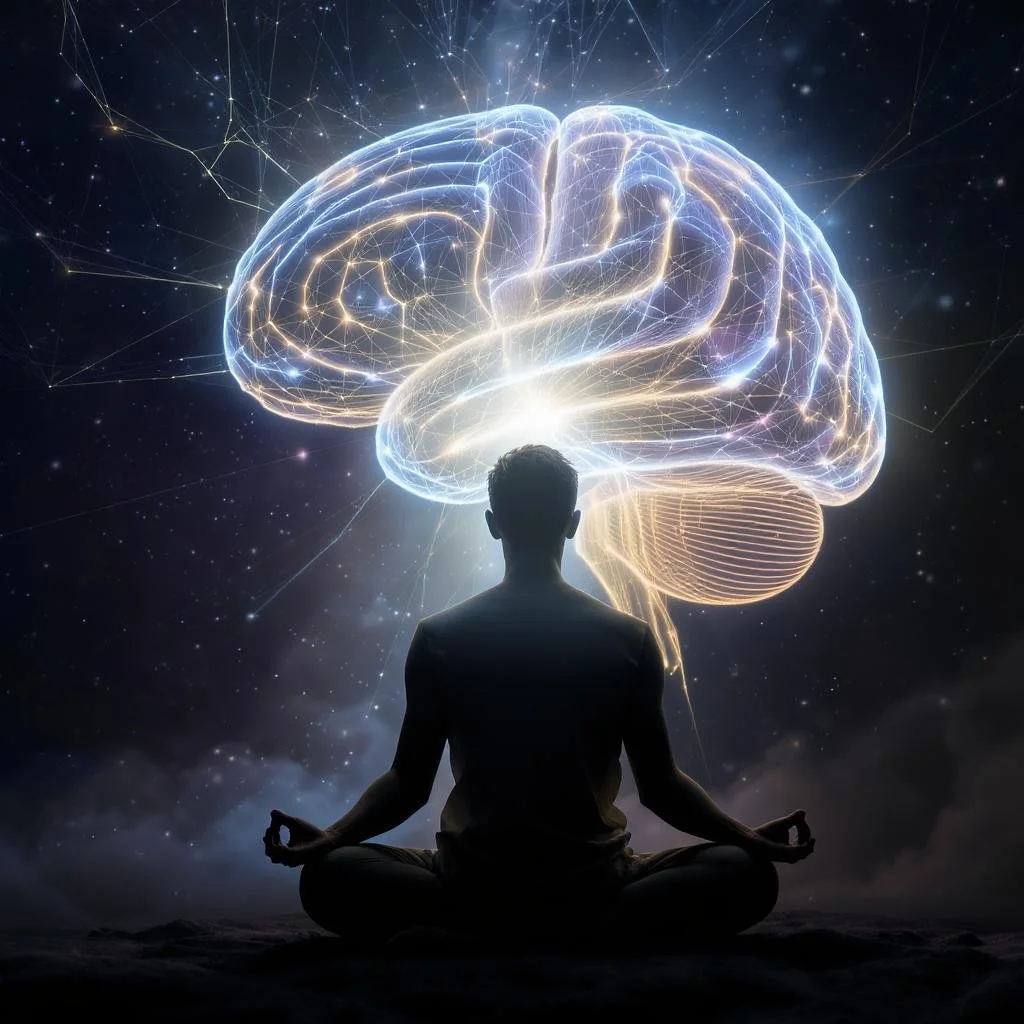The Neuroscience of Awakening: What Meditation Does to Your Brain
Where Science Meets the Sacred
For centuries, spiritual traditions and mystics have spoken of awakening: an inner shift from separation to connection, fear to presence, survival to soul.
But today, neuroscience is able to reveal what this transformation looks like inside the brain. The sacred isn’t just poetic — it’s also physiological.
Through advanced imaging tools and decades of research, scientists are beginning to map what mystics have always known: when we meditate, we transform. Not just spiritually — biologically.
What Meditation Does to the Brain
Meditation is much more powerful than simply relaxing. It’s rewiring — a practice that reshapes how we think, feel, and experience ourselves and the world.
Here’s what the science says:
1. It Deactivates the Default Mode Network (DMN)
The DMN is the part of your brain associated with ego, rumination, and repetitive self-focused thinking. These are the neural networks that were created within the ages of 3-14 ; the networks that create our sense of Self and all of the meaning we project onto the world around us. However, during meditation, the DMN quiets down — allowing space for clarity, spaciousness, and expanded awareness.
This is often when people report feeling “more like themselves” — or even connected to something larger than the self.
2. It Increases Gamma Wave Activity
Brave wave activity is one of the most important pieces of the puzzle. In our normal waking day, we are typically in Beta - this is the state of the analytical mind, planning, etc. In meditation, we shift into Alpha, Theta, and even Gamma. Gamma brainwaves are associated with peak awareness, insight, and unity consciousness. Long-term meditators show elevated gamma states — especially during moments of deep stillness or compassion.
These states correlate with what many describe as moments of spiritual awakening or transcendent oneness.
3. It Builds Gray Matter in Key Regions
Studies show that consistent meditation leads to measurable increases in gray matter in the prefrontal cortex (attention + decision-making), the hippocampus (memory + emotion), and the insula (self-awareness).
The result? A mind that’s not just quieter, but more integrated, compassionate, and capable of holding complexity.
4. It Enhances Interoception
Interoception is your ability to sense what’s happening inside your body — from your heartbeat to your gut feelings. Meditation heightens this capacity, which leads to greater emotional regulation and intuitive perception. Imagine noticing exactly when you’re heart rate elevates and using your mind body connection to regulate it…one’s ability to be in their body is truly a superpower.
Translation: the body becomes a clearer instrument for inner truth.
Spiritual Awakening Through a Scientific Lens
The brain is not the source of consciousness — but it is the interface.
And when we meditate, we’re essentially tuning that interface — clearing out static, strengthening the signal, and allowing more coherent states of awareness to emerge. It's like updating the software of our inner operating system — one breath, one still moment at a time.
From the SoulPod lens, meditation isn’t about escaping the mind — it’s about healing the split between mind, body, and spirit. It's a return to coherence, to wholeness, to the natural intelligence of the self.
As the Default Mode Network quiets, as gamma waves rise, as interoceptive awareness grows — we don’t just feel different. We become more ourselves. We begin to call more of our Soul into this human experience. We begin to experience life not through the filter of fear or fragmentation, but through the lens of presence, clarity, and connection.
This is the terrain of spiritual awakening: a rewiring of both the brain and the being. It’s not abstract or out of reach. It’s a process — one you’re already biologically built for.
That “something” that opens when the mind softens and the breath slows? It has many names: presence, God, Source, the Self, consciousness, love. Science may not name it — but more and more, it's pointing toward it. And that’s where SoulPod lives: at the crossroads of evidence and essence, practice and mystery.
How to Use Meditation as a Tool for Awakening
You don’t need hours of silence or a monastery to experience the benefits. What you need is consistency, intention, and a willingness to listen deeply.
Try these:
1. Breath + Stillness (10 min)
Sit comfortably. Let the breath guide you inward. When thoughts arise, notice them, then return to the breath.
This calms the nervous system, quiets the DMN, and begins to change your baseline brain state.
2. Third Eye Visualization (7–10 min)
Bring your awareness to the space between your brows. Visualize a glowing indigo light, pulsing gently. Invite clarity, and see what arises.
This strengthens intuitive awareness and promotes gamma activity.
3. Body Awareness Scan (5–15 min)
Move your attention slowly from the crown of your head down to your toes, noting sensation, tension, or emotion without judgment.
This deepens interoception — helping you listen to the subtle cues of your body and intuition.
SoulPod: Where Science and Spirituality Meet
At SoulPod, we’re here to bridge these worlds — offering tools that honor both neuroscience and mysticism.
Our app is a space where:
Meditation meets frequency healing
Breathwork supports emotional alchemy
Binaural soundscapes shift your brainwaves
Guided rituals open portals to insight
Whether you’re new to meditation or deep in your journey, SoulPod offers a grounded path to awakening — one rooted in both evidence and energy.
🎧 Tap into your next layer of consciousness inside the SoulPod App.
You don’t have to choose between science and soul. You’re made of both.

